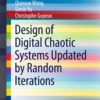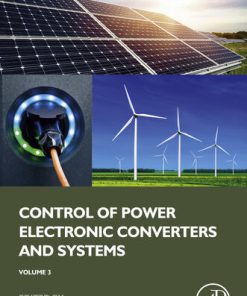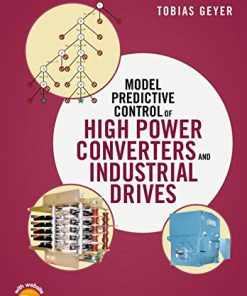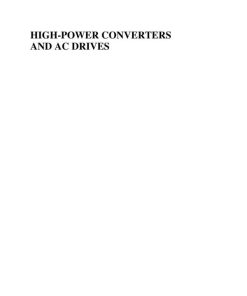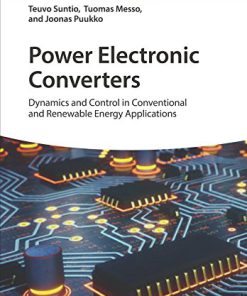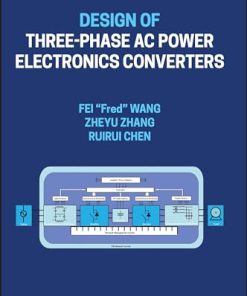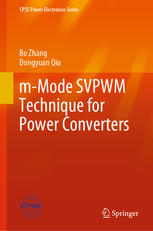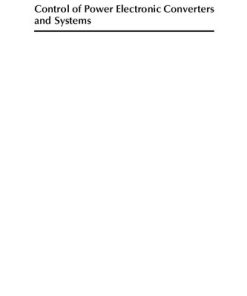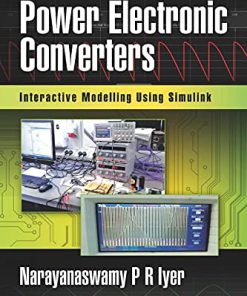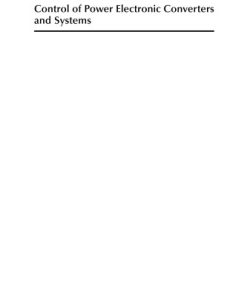Impedance source power electronic converters 1st Edition by Yushan Liu 1119037101 9781119037101
$50.00 Original price was: $50.00.$25.00Current price is: $25.00.
Impedance source power electronic converters 1st Edition by Yushan Liu – Ebook PDF Instant Download/DeliveryISBN: 1119037101, 9781119037101
Full download Impedance source power electronic converters 1st Edition after payment.
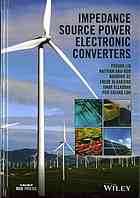
Product details:
ISBN-10 : 1119037101
ISBN-13 : 9781119037101
Author: Yushan Liu
Impedance Source Power Electronic Converters brings together state of the art knowledge and cutting edge techniques in various stages of research related to the ever more popular impedance source converters/inverters. Significant research efforts are underway to develop commercially viable and technically feasible, efficient and reliable power converters for renewable energy, electric transportation and for various industrial applications. This book provides a detailed understanding of the concepts, designs, controls, and application demonstrations of the impedance source converters/inverters. Key features: Comprehensive analysis of the impedance source converter/inverter topologies, including typical topologies and derived topologies. Fully explains the design and control techniques of impedance source converters/inverters, including hardware design and control parameter design for corresponding control methods. Presents the latest power conversion solutions that aim to advance the role of power electronics into industries and sustainable energy conversion systems. Compares impedance source converter/inverter applications in renewable energy power generation and electric vehicles as well as different industrial applications. Provides an overview of existing challenges, solutions and future trends. Supported by calculation examples, simulation models and results. Highly accessible, this is an invaluable resource for researchers, postgraduate/graduate students studying power electronics and its application in industry and renewable energy conversion as well as practising R&D engineers. Readers will be able to apply the presented material for the future design of the next generation of efficient power electronic converters/inverters.
Impedance source power electronic converters 1st Table of contents:
1 Background and Current Status
1.1 General Introduction to Electrical Power Generation
1.2 Z-Source Converter as Single-Stage Power Conversion System
1.3 Background and Advantages Compared to Existing Technology
1.4 Classification and Current Status
1.5 Future Trends
1.6 Contents Overview
Acknowledgment
References
2 Voltage-Fed Z-Source/Quasi-Z-Source Inverters
2.1 Topologies of Voltage-Fed Z-Source/Quasi-Z-Source Inverters
2.2 Modeling of Voltage-Fed qZSI
2.3 Simulation Results
2.4 Conclusion
References
3 Current-Fed Z-Source Inverter
3.1 Introduction
3.2 Topology Modification
3.3 Operational Principles
3.4 Modulation
3.5 Modeling and Control
3.6 Passive Components Design Guidelines
3.7 Discontinuous Operation Modes
3.8 Current-Fed Z-Source Inverter/Current-Fed Quasi-Z-Source Inverter Applications
3.9 Summary
References
4 Modulation Methods and Comparison
4.1 Sinewave Pulse-Width Modulations
4.2 Space Vector Modulations
4.3 Pulse-Width Amplitude Modulation
4.4 Comparison of All Modulation Methods
4.5 Conclusion
References
5 Control of Shoot-Through Duty Cycle: An Overview
5.1 Summary of Closed-Loop Control Methods
5.2 Single-Loop Methods
5.3 Double-Loop Methods
5.4 Conventional Regulators and Advanced Control Methods
References
6 Z-Source Inverter: Topology Improvements Review
6.1 Introduction
6.2 Basic Topology Improvements
6.3 Extended Boost Topologies
6.4 L-Z-Source Inverter
6.5 Changing the ZSI Topology Arrangement
6.6 Conclusion
References
7 Typical Transformer-Based Z-Source/Quasi-Z-Source Inverters
7.1 Fundamentals of Trans-ZSI
7.2 LCCT-ZSI/qZSI
7.3 Conclusion
Acknowledgment
References
8 Z-Source/Quasi-Z-Source AC-DC Rectifiers
8.1 Topologies of Voltage-Fed Z-Source/Quasi-Z-Source Rectifiers
8.2 Operating Principle
8.3 Dynamic Modeling
8.4 Simulation Results
8.5 Conclusion
References
9 Z-Source DC-DC Converters
9.1 Topologies
9.2 Comparison
9.3 Example Simulation Model and Results
References
10 Z-Source Matrix Converter
10.1 Introduction
10.2 Z-Source Indirect Matrix Converter (All-Silicon Solution)
10.3 Z-Source Indirect Matrix Converter (Not All-Silicon Solution)
10.4 Z-Source Direct Matrix Converter
10.5 Summary
References
11 Energy Stored Z-Source/Quasi-Z-Source Inverters
11.1 Energy Stored Z-Source/Quasi-Z Source Inverters
11.2 Example Simulations
11.3 Conclusion
References
12 Z-Source Multilevel Inverters
12.1 Z-Source NPC Inverter
12.2 Z-Source/Quasi-Z-Source Cascade Multilevel Inverter
12.3 Conclusion
Acknowledgment
References
13 Design of Z-Source and Quasi-Z-Source Inverters
13.1 Z-Source Network Parameters
13.2 Loss Calculation Method
13.3 Voltage and Current Stress
13.4 Coupled Inductor Design
13.5 Efficiency, Cost, and Volume Comparison with Conventional Inverter
13.6 Conclusion
References
14 Applications in Photovoltaic Power Systems
14.1 Photovoltaic Power Characteristics
14.2 Typical Configurations of Single-Phase and Three-Phase Systems
14.3 Parameter Design Method
14.4 MPPT Control and System Control Methods
14.5 Examples Demonstration
14.6 Conclusion
References
15 Applications in Wind Power
15.1 Wind Power Characteristics
15.2 Typical Configurations
15.3 Parameter Design
15.4 MPPT Control and System Control Methods
15.5 Simulation Results of a qZS Wind Power System
15.6 Conclusion
References
16 Z-Source Inverter for Motor Drives Application: A Review
16.1 Introduction
16.2 Z-Source Inverter Feeding a Permanent Magnet Brushless DC Motor
16.3 Z-Source Inverter Feeding a Switched Reluctance Motor
16.4 Z-Source Inverter Feeding a Permanent Magnet Synchronous Motor
16.5 Z-Source Inverter Feeding an Induction Motor
16.6 Multiphase Z-Source Inverter Motor Drive System
16.7 Two-Phase Motor Drive System with Z-Source Inverter
16.8 Single-Phase Induction Motor Drive System Using Z-Source Inverter
16.9 Z-Source Inverter for Vehicular Applications
16.10 Conclusion
References
17 Impedance Source Multi-Leg Inverters
17.1 Impedance Source Four-Leg Inverter
17.2 Impedance Source Five-Leg (Five-Phase) Inverter
17.3 Summary
References
18 Model Predictive Control of Impedance Source Inverter
18.1 Introduction
18.2 Overview of Model Predictive Control
18.3 Mathematical Model of the Z-Source Inverters
18.4 Model Predictive Control of the Z-Source Three-Phase Three-Leg Inverter
18.5 Model Predictive Control of the Z-Source Three-Phase Four-Leg Inverter
18.6 Model Predictive Control of the Z-Source Five-Phase Inverter
18.7 Performance Investigation
18.8 Summary
References
19 Grid Integration of Quasi-Z Source Based PV Multilevel Inverter
19.1 Introduction
19.2 Topology and Modeling
19.3 Grid Synchronization
19.4 Power Flow Control
19.5 Low Voltage Ride-Through Capability
19.6 Islanding Protection
19.7 Conclusion
References
20 Future Trends
20.1 General Expectation
20.2 Illustration of Using Wide Band Gap Devices
20.3 Conclusion
People also search for Impedance source power electronic converters 1st:
different types of power electronic converters
how to measure electrical impedance
impedance of power supply
power supply source impedance
impedance electronics
Tags: Impedance, source power, electronic converters, Yushan Liu
You may also like…
Engineering
Control of Power Electronic Converters and Systems: Volume 3 1st Edition Frede Blaabjerg (Editor)
Engineering
Engineering - Electrical & Electronic Engineering



